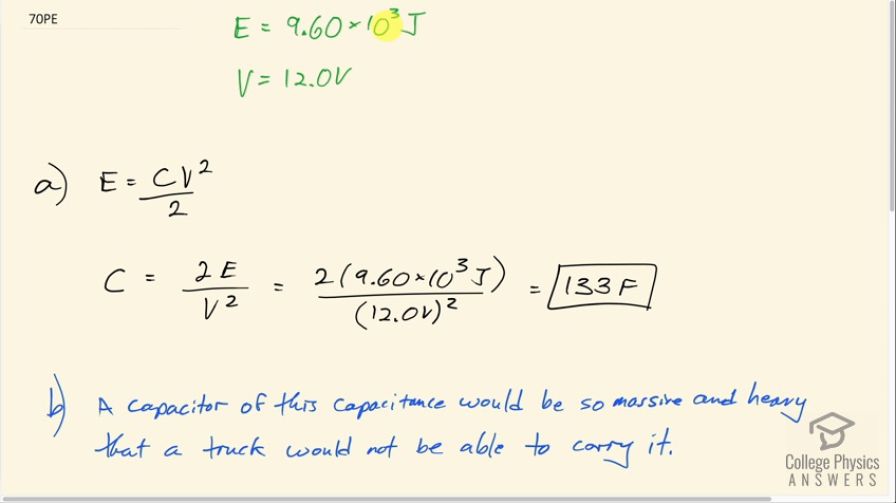Question
(a) On a particular day, it takes of electric
energy to start a truck’s engine. Calculate the capacitance of a capacitor that could store that amount of energy at 12.0 V. (b) What is unreasonable about this result? (c) Which assumptions are responsible?
Final Answer
- A capacitor of this capacitance would be so massive and heavy that a truck would not be able to carry it. If we assumed the capacitor is a parallel plate capacitor with the highest capacity dielectric, strontium titanate, with square plates, the side length of the square would be 254 km!
- It's unreasonable to presume this energy could be supplied by a capacitor. Batteries are used instead.
Solution video
OpenStax College Physics for AP® Courses, Chapter 19, Problem 70 (Problems & Exercises)

vote with a rating of
votes with an average rating of
.
Calculator Screenshots
Video Transcript
This is College Physics Answers with Shaun Dychko. A truck engine has a 12.0 volt source of energy and the amount of energy is 9.60 times 10 to the 3 joules to start the engine and we are asked in part (a), what is the capacitance if a capacitor is supplying this energy? So the energy stored in the capacitor is its capacitance multiplied by the voltage squared divided by 2 and we can solve this for C by multiplying both sides by 2 over V squared. So the capacitance is 2 times the energy divided by the voltage squared. So that's 2 times 9.60 times 10 to the 3 joules divided by 12.0 volts squared which is 133 farads. Now this capacitance is really, really huge even though the number 133 doesn't seem so big, when it comes to capacitance, it's a very big number. A capacitance this big would be so heavy and massive that a truck would not be able to carry it and we can demonstrate that by assuming suppose that the capacitor is a parallel-plate capacitor in which case, this is the formula for its capacitance. We'll make an assumption about what the dielectric constant is and I have taken the most generous possible assumption that the dielectric material is 'Strontium titanate' with this highest dielectric constant of 233, and then suppose the plates are separated by 1.00 meter, let's figure out what the area of each of the plates would have to be and we'll solve for A by multiplying both sides by d over Kε0. And so the area would be 1.0 meter times 133 farads divided by 233—dielectric constant— multiplied by 8.85 times 10 to the minus 12 farads per meter— permittivity of free space— and this makes 6.4 times 10 to the 10 square meters; that's huge and if you take the square root of that and you assume that the plate is a square then this would be a square with side length 254 kilometers and clearly, no truck could ever carry that. So it's unreasonable to think that the energy would come from a capacitor; batteries are what's used instead.
